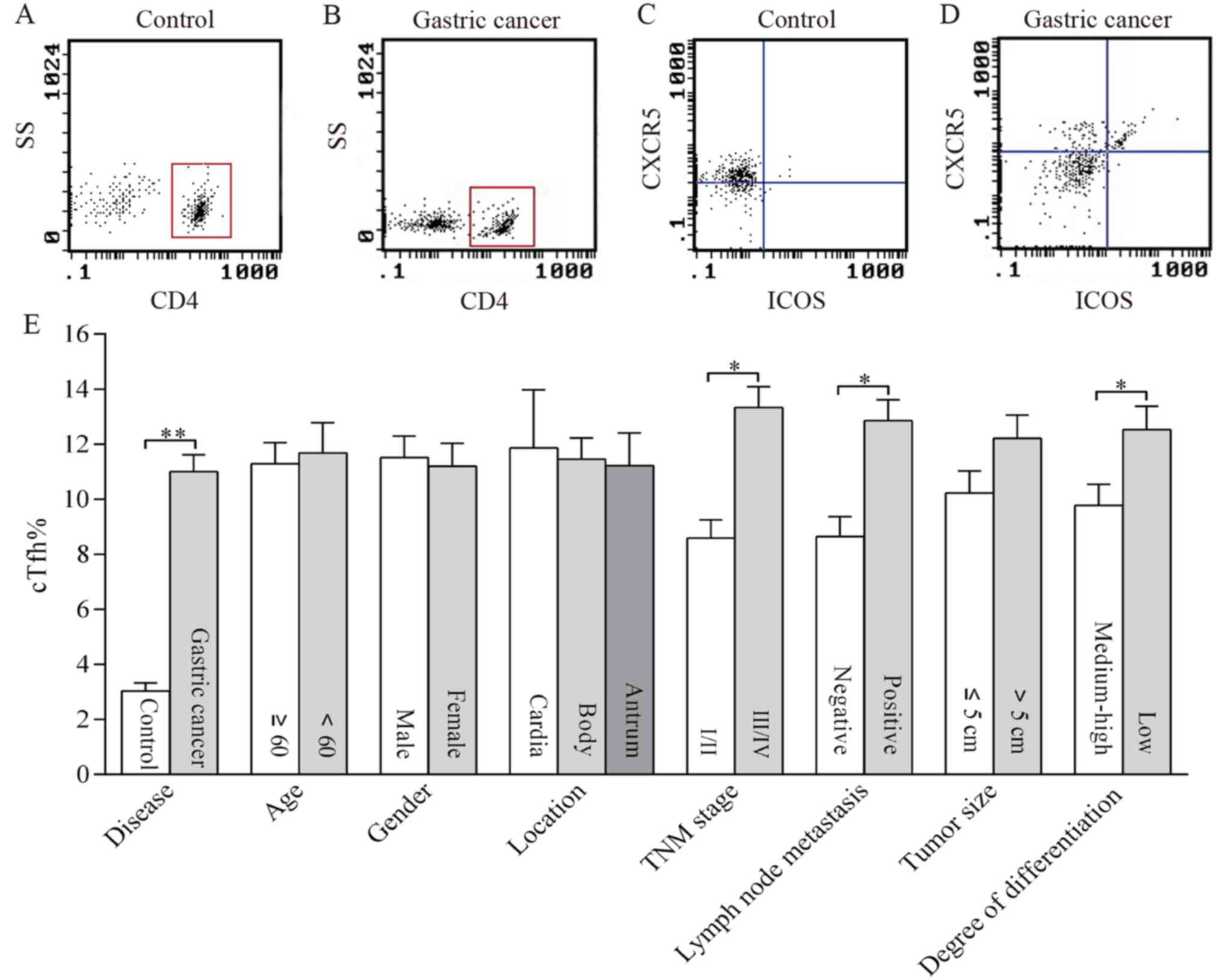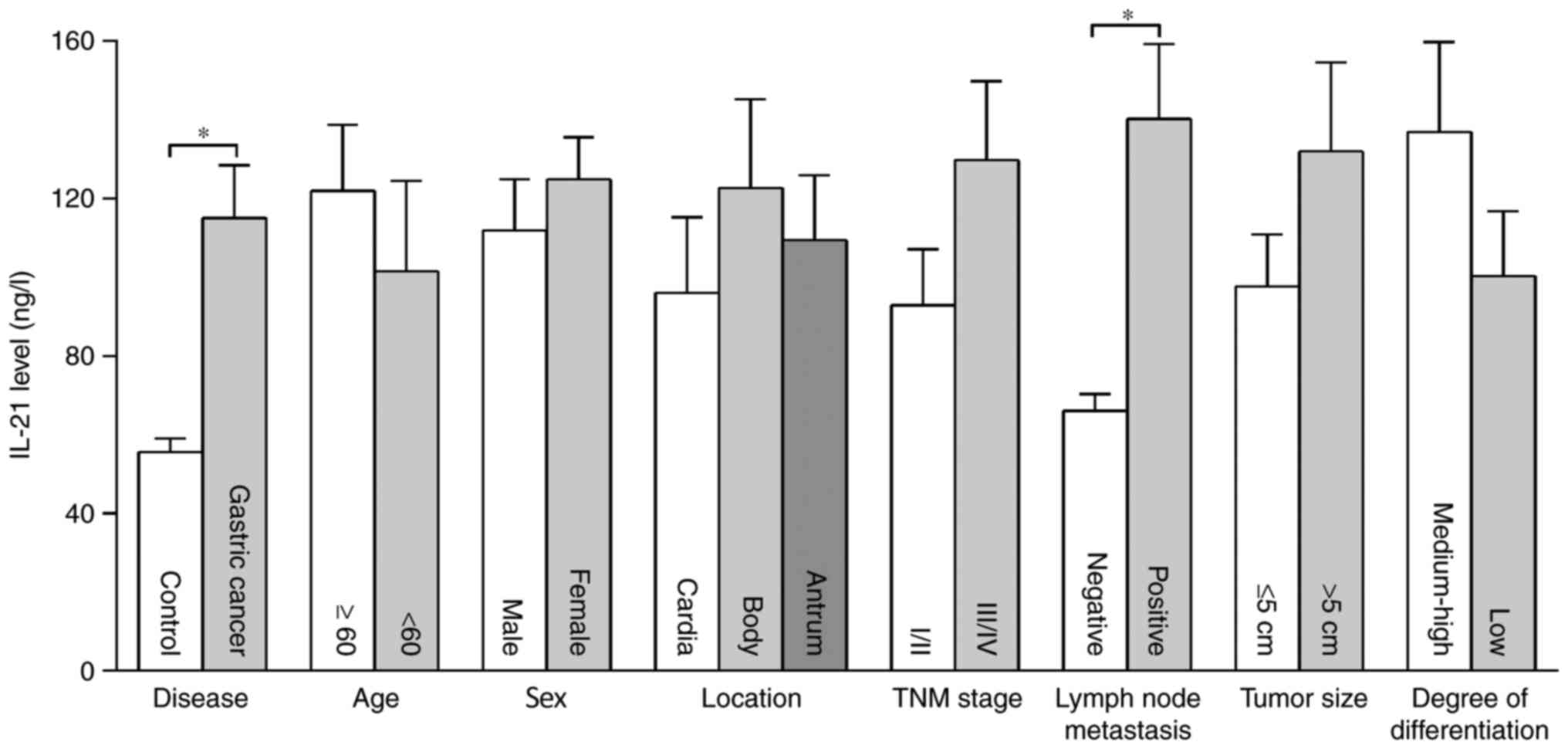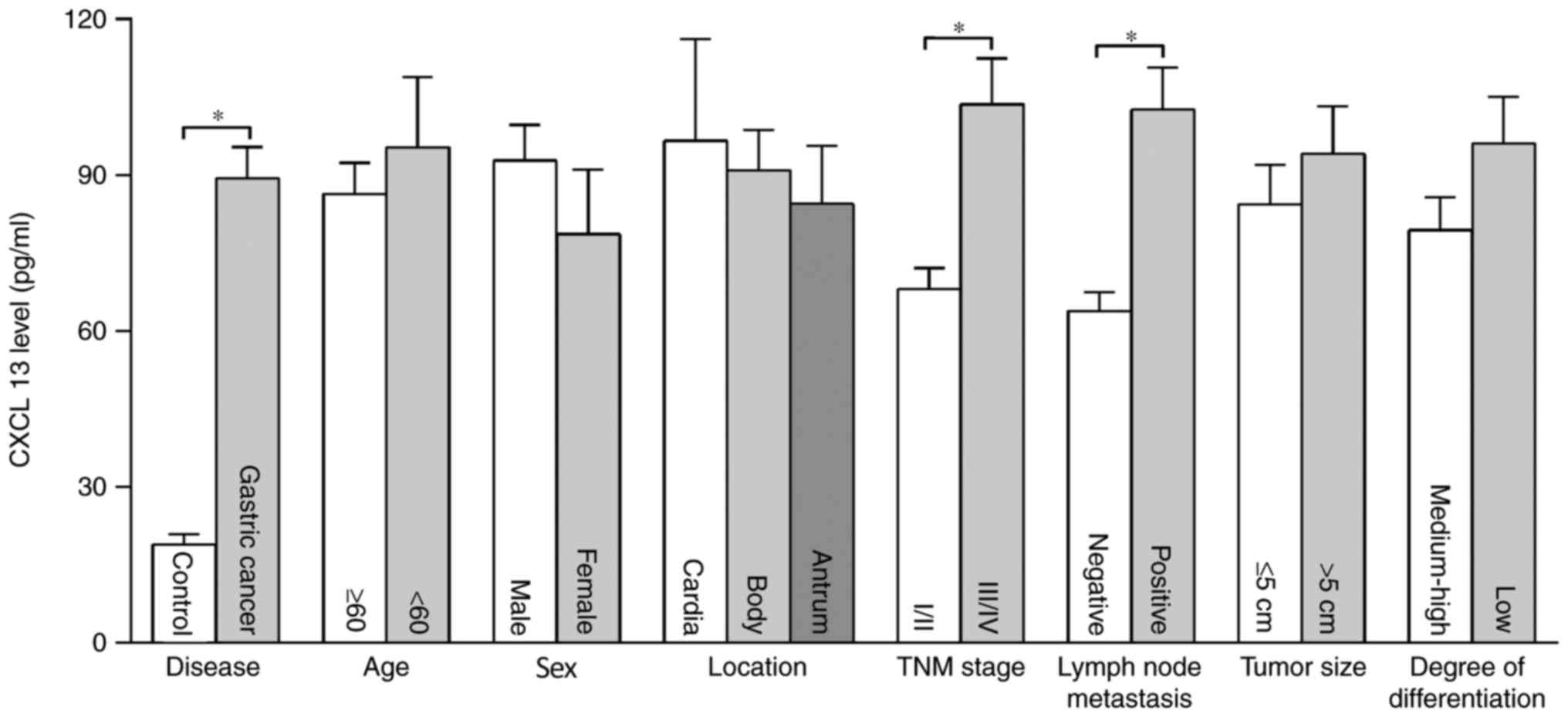|
1
|
Karimi P, Islami F, Anandasabapathy S,
Freedman ND and Kamangar F: Gastric cancer: Descriptive
epidemiology, risk factors, screening and prevention. Cancer
Epidemiol Biomarkers Prev. 23:700–713. 2014. View Article : Google Scholar : PubMed/NCBI
|
|
2
|
Chen W, Zheng R, Baade PD, Zhang S, Zeng
H, Bray F, Jemal A, Yu XQ and He J: Cancer statistics in China,
2015. CA Cancer J Clin. 66:115–132. 2016. View Article : Google Scholar : PubMed/NCBI
|
|
3
|
Li Q, Li Q, Chen J, Liu Y, Zhao X, Tan B,
Ai J, Zhang Z, Song J and Shan B: Prevalence of Th17 and Treg cells
in gastric cancer patients and its correlation with clinical
parameters. Oncol Rep. 30:1215–1222. 2013. View Article : Google Scholar : PubMed/NCBI
|
|
4
|
Meng XY, Zhou CH, Ma J, Jiang C and Ji P:
Expression of interleukin-17 and its clinical significance in
gastric cancer patients. Med Oncol. 29:3024–3028. 2012. View Article : Google Scholar : PubMed/NCBI
|
|
5
|
Xu Y, Gao J, Su Z, Dai X, Li Y, Liu Y,
Chen J, Tong J, Zhang Y, Wu C, et al: Downregulation of Hlx closely
related to the decreased expressions of T-bet and Runx3 in patients
with gastric cancer may be associated with a pathological event
leading to the imbalance of Th1/Th2. Clin Dev Immunol.
2012:9498212012. View Article : Google Scholar : PubMed/NCBI
|
|
6
|
Schaerli P, Willimann K, Lang AB, Lipp M,
Loetscher P and Moser B: CXC chemokine receptor 5 expression
defines follicular homing T cells with B cell helper function. J
Exp Med. 192:1553–1562. 2000. View Article : Google Scholar : PubMed/NCBI
|
|
7
|
Liu J, Zhou Y, Yu Q, Zhao Z, Wang H, Luo
X, Chen Y, Zhu Z, Chen G, Wu M and Qiu L: Higher frequency of
CD4+CXCR5+ICOS+PD1+ T follicular helper cells in patients with
infectious mononucleosis. Medicine (Baltimore). 94:e20612015.
View Article : Google Scholar : PubMed/NCBI
|
|
8
|
Ma CS and Deenick EK: Human T follicular
helper (Tfh) cells and disease. Immunol Cell Biol. 92:64–71. 2014.
View Article : Google Scholar : PubMed/NCBI
|
|
9
|
Schmitt N, Bentebibel SE and Ueno H:
Phenotype and functions of memory Tfh cells in human blood. Trends
Immunol. 35:436–442. 2014. View Article : Google Scholar : PubMed/NCBI
|
|
10
|
Simpson N, Gatenby PA, Wilson A, Malik S,
Fulcher DA, Tangye SG, Manku H, Vyse TJ, Roncador G, Huttley GA, et
al: Expansion of circulating T cells resembling follicular helper T
cells is a fixed phenotype that identifies a subset of severe
systemic lupus erythematosus. Arthritis Rheum. 62:234–244. 2010.
View Article : Google Scholar : PubMed/NCBI
|
|
11
|
Forcade E, Kim HT, Cutler C, Wang K, Alho
AC, Nikiforow S, Ho VT, Koreth J, Armand P, Alyea EP, et al:
Circulating T follicular helper cells with increased function
during chronic graft-versus-host disease. Blood. 127:2489–2497.
2016. View Article : Google Scholar : PubMed/NCBI
|
|
12
|
Zhang M, Zhang L, Li H, Chen Z, Luo A, Liu
B, Chen M, Peng M, Ren H and Hu P: Circulating T follicular helper
cells are associated with rapid virological response in chronic
hepatitis C patients undergoing peginterferon therapy. Int
Immunopharmacol. 34:235–243. 2016. View Article : Google Scholar : PubMed/NCBI
|
|
13
|
Szabo K, Papp G, Szanto A, Tarr T and
Zeher M: A comprehensive investigation on the distribution of
circulating follicular T helper cells and B cell subsets in primary
Sjogren's syndrome and systemic lupus erythematosus. Clin Exp
Immunol. 183:76–89. 2016. View Article : Google Scholar : PubMed/NCBI
|
|
14
|
Shi W, Li X, Cha Z, Sun S, Wang L, Jiao S,
Yang B, Shi Y, Wang Z, Wu Z and Dai G: Dysregulation of circulating
follicular helper T cells in nonsmall cell lung cancer. DNA Cell
Biol. 33:355–360. 2014. View Article : Google Scholar : PubMed/NCBI
|
|
15
|
Davis MR, Zhu Z, Hansen DM, Bai Q and Fang
Y: The role of IL-21 in immunity and cancer. Cancer Lett.
358:107–114. 2015. View Article : Google Scholar : PubMed/NCBI
|
|
16
|
Cha Z, Qian G, Zang Y, Gu H, Huang Y, Zhu
L, Li J, Liu Y, Tu X, Song H and Qian B: Circulating CXCR5+CD4+ T
cells assist in the survival and growth of primary diffuse large B
cell lymphoma cells through interleukin 10 pathway. Exp Cell Res.
350:154–160. 2017. View Article : Google Scholar : PubMed/NCBI
|
|
17
|
Dupuis J, Boye K, Martin N, Copie-Bergman
C, Plonquet A, Fabiani B, Baglin AC, Haioun C, Delfau-Larue MH and
Gaulard P: Expression of CXCL13 by neoplastic cells in
angioimmunoblastic T-cell lymphoma (AITL): a new diagnostic marker
providing evidence that AITL derives from follicular helper T
cells. Am J Surg Pathol. 30:490–494. 2006. View Article : Google Scholar : PubMed/NCBI
|
|
18
|
Jin L, Yu D, Li X, Yu N, Li X and Wang Y
and Wang Y: CD4+CXCR5+ follicular helper T cells in salivary gland
promote B cells maturation in patients with primary Sjogren's
syndrome. Int J Clin Exp Pathol. 7:1988–1996. 2014.PubMed/NCBI
|
|
19
|
Zhu S, Lin J, Qiao G, Wang X and Xu Y:
Tim-3 identifies exhausted follicular helper T cells in breast
cancer patients. Immunobiology. 221:986–993. 2016. View Article : Google Scholar : PubMed/NCBI
|
|
20
|
Tian Y, Yuan C, Ma D, Zhang Y, Liu Y,
Zhang W, Hou F and Cui B: IL-21 and IL-12 inhibit differentiation
of Treg and TH17 cells and enhance cytotoxicity of peripheral blood
mononuclear cells in patients with cervical cancer. Int J Gynecol
Cancer. 21:1672–1678. 2011. View Article : Google Scholar : PubMed/NCBI
|
|
21
|
Zhu Z, Zhang X, Guo H, Fu L, Pan G and Sun
Y: CXCL13-CXCR5 axis promotes the growth and invasion of colon
cancer cells via PI3K/AKT pathway. Mol Cell Biochem. 400:287–295.
2015. View Article : Google Scholar : PubMed/NCBI
|
|
22
|
Deng J, Zhang R, Zhang L, Liu Y, Hao X and
Liang H: Negative node count improvement prognostic prediction of
the seventh edition of the TNM classification for gastric cancer.
PLoS One. 8:e800822013. View Article : Google Scholar : PubMed/NCBI
|
|
23
|
Wang Z, Wang Z, Diao Y, Qian X, Zhu N and
Dong W: Circulating follicular helper T cells in Crohn's disease
(CD) and CD-associated colorectal cancer. Tumour Biol.
35:9355–9359. 2014. View Article : Google Scholar : PubMed/NCBI
|
|
24
|
Sondergaard H and Skak K: IL-21: Roles in
immunopathology and cancer therapy. Tissue Antigens. 74:467–479.
2009. View Article : Google Scholar : PubMed/NCBI
|
|
25
|
Skak K, Kragh M, Hausman D, Smyth MJ and
Sivakumar PV: Interleukin 21 combination strategies for cancer
therapy. Nat Rev Drug Discov. 7:231–240. 2008. View Article : Google Scholar : PubMed/NCBI
|
|
26
|
Kannappan V, Butcher K, Trela M, Nicholl
I, Wang W and Attridge K: Interleukin 21 inhibits cancer-mediated
FOXP3 induction in naïve human CD4 T cells. Cancer Immunol
Immunother. 6:637–645. 2017. View Article : Google Scholar
|
|
27
|
You Y, Deng J, Zheng J, Hu M, Li N, Wu H,
Li W, Lu J and Zhou Y: IL-21 gene polymorphism is associated with
the prognosis of breast cancer in Chinese populations. Breast
Cancer Res Treat. 137:893–901. 2013. View Article : Google Scholar : PubMed/NCBI
|
|
28
|
Su Z, Sun Y, Zhu H, Liu Y, Lin X, Shen H,
Chen J, Xu W and Xu H: Th17 cell expansion in gastric cancer may
contribute to cancer development and metastasis. Immunol Res.
58:118–124. 2014. View Article : Google Scholar : PubMed/NCBI
|
|
29
|
Biswas S, Sengupta S, Chowdhury Roy S,
Jana S, Mandal G, Mandal PK, Saha N, Malhotra V, Gupta A, Kuprash
DV and Bhattacharyya A: CXCL13-CXCR5 co-expression regulates
epithelial to mesenchymal transition of breast cancer cells during
lymph node metastasis. Breast Cancer Res Treat. 143:265–276. 2014.
View Article : Google Scholar : PubMed/NCBI
|
|
30
|
Qi XW, Xia SH, Yin Y, Jin LF, Pu Y, Hua D
and Wu HR: Expression features of CXCR5 and its ligand, CXCL13
associated with poor prognosis of advanced colorectal cancer. Eur
Rev Med Pharmacol Sci. 18:1916–1924. 2014.PubMed/NCBI
|
|
31
|
El-Haibi CP, Singh R, Gupta P, Sharma PK,
Greenleaf KN, Singh S and Lillard JW Jr: Antibody microarray
analysis of sSignaling networks regulated by cxcl13 and cxcr5 in
prostate cancer. J Proteomics Bioinform. 5:177–184. 2012.
View Article : Google Scholar : PubMed/NCBI
|
|
32
|
Spolski R and Leonard WJ: IL-21 and T
follicular helper cells. Int Immunol. 22:7–12. 2010. View Article : Google Scholar : PubMed/NCBI
|
|
33
|
Havenar-Daughton C, Lindqvist M, Heit A,
Wu JE, Reiss SM, Kendric K, Bélanger S, Kasturi SP, Landais E,
Akondy RS, et al: CXCL13 is a plasma biomarker of germinal center
activity. Proc Natl Acad Sci USA. 113:2702–2707. 2016. View Article : Google Scholar : PubMed/NCBI
|
|
34
|
An LF, Zhang XH, Sun XT, Zhao LH, Li S and
Wang WH: Unexplained infertility patients have increased serum
IL-2, IL-4, IL-6, IL-8, IL-21, TNFα, IFNγ and increased Tfh/CD4 T
cell ratio: Increased Tfh and IL-21 strongly correlate with
presence of autoantibodies. Immunol Invest. 44:164–173. 2015.
View Article : Google Scholar : PubMed/NCBI
|
|
35
|
Duan MC, Huang Y, Zhong XN and Tang HJ:
Th17 cell enhances CD8 T-cell cytotoxicity via IL-21 production in
emphysema mice. Mediators Inflamm. 2012:8980532012. View Article : Google Scholar : PubMed/NCBI
|
|
36
|
Coquet JM, Kyparissoudis K, Pellicci DG,
Besra G, Berzins SP, Smyth MJ and Godfrey DI: IL-21 is produced by
NKT cells and modulates NKT cell activation and cytokine
production. J Immunol. 178:2827–2834. 2007. View Article : Google Scholar : PubMed/NCBI
|
|
37
|
Gunn MD, Ngo VN, Ansel KM, Ekland EH,
Cyster JG and Williams LT: A B-cell-homing chemokine made in
lymphoid follicles activates Burkitt's lymphoma receptor-1. Nature.
391:799–803. 1998. View
Article : Google Scholar : PubMed/NCBI
|
|
38
|
Hardtke S, Ohl L and Förster R: Balanced
expression of CXCR5 and CCR7 on follicular T helper cells
determines their transient positioning to lymph node follicles and
is essential for efficient B-cell help. Blood. 106:1924–1931. 2005.
View Article : Google Scholar : PubMed/NCBI
|
|
39
|
Linterman MA and Vinuesa CG: Signals that
influence T follicular helper cell differentiation and function.
Semin Immunopathol. 32:183–196. 2010. View Article : Google Scholar : PubMed/NCBI
|













